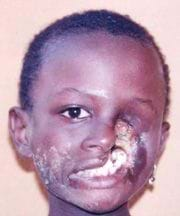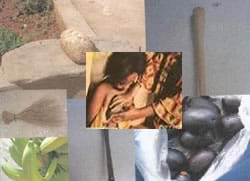COTONOU, 11 April 2008 (IRIN) - In just four months the face of this child in northern Benin was eaten away by the disease known as Noma. And yet it could have easily been prevented.
The disease is not communicable, experts say. The cause is simply poor nutrition and oral hygiene.
Noma starts in the mouth as a oral lesion that then becomes gangrenous, rapidly destroying soft and hard tissues of the mouth and face.
Over 100,000 children suffer from it each year, according to the Winds of Hope Foundation which provides support, most of them in Africa.
If detected early, it can be treated easily with vitamins, mouthwash and common antibiotics. If treated late - as with this child – major surgery is required and only 50 percent of patients survive.
If Noma goes untreated then up to 90 percent of children die. “Those who survive are forced to live with permanent disfiguration and the inability to eat or breathe normally,” said Bertrand Piccard, Winds of Hope president who is an organizer for World Noma Day on 22 May.
The victims are mostly under the age of six, although in Benin some are as old as 15, the head of the Noma project for the ministry of health, Sylvie Bankolé Pognon.
Benin’s government has registered 57 cases since 2007, she said although the real number is likely higher. “We still need to do a [proper] evaluation,” Pognon said.
At least two of the 57 children are HIV positive, Pognon said. ”HIV increases the risk [of Noma] because it opens the door to all sorts of infections.”
So far, the project she runs lacks any government funding, she added. “The only support we get is from donatives,” she said, naming the Winds of Hope and the UN World Health Organisation.
Early detection is key but for that health workers and traditional healers need training, and the community, particular mothers, need to be made aware of how to detect the disease. “[They must] be able to recognize the first signs of noma and take [the child] to the nearest hospital," Pognon said.
gc/dh
Source: IRIN








